Bimalleolar and Trimalleolar Ankle Fractures
Bimalleolar and Trimalleolar Ankle Fractures
The ankle joint is where the bones of the leg (the tibia and fibula) meet with the bones on the hindfoot (talus) to form a joint that allows the foot to bend up and down. The ankle joint is susceptible to injury and one common typeof injury is called an ankle fracture. Ankle fractures can occur from many types of trauma including slips on the ice, a fall down stairs, sports injuries, and car crashes.
Read more about : Leg lengthening surgery success story in Iran
Read more about : Total knee replacement surgery success story in Iran
Causes
An ankle fracture can be caused in many ways, and because of that, each individual injury is slightly different and the treatment and recovery may very significantly from one injury to another. Some people are confused when they have an ankle fracture that requires surgery and prolonged therapy when someone else they know just wore a brace for a few weeks. While both of these injuries were ankle fractures, they were clearly very different and had different timelines for recovery.
When a bimalleolar ankle fracture occurs, there is an injury to both the medial malleolus (inner side of the ankle) and the lateral malleolus (outer side of the ankle). Because both sides are injured, the ankle joint becomes unstable. An unstable injury occurs when the fracture disrupts the structural integrity of the ankle (joint). Because the joint is unstable, it is susceptible to damage and early ankle arthritis if left untreated. Therefore, the typical treatment is to surgically repair the fracture to stabilize the ankle joint.
One special subset of these fractures is called a bimalleolar equivalent fracture. This typically occurs when there is a fracture of the lateral malleolus and a ligament injury on the inner side of the ankle (the deltoid ligament). While this particular injury does not involve a bone injury on the inner side of the ankle, the ligament injury that has occurred causes the ankle joint to become unstable and requires surgical treatment to stabilize the joint.
Trimalleolar Ankle Fractures
Another variant of this type of injury is called a trimalleolar ankle fracture. The typical bimalleolar fracture involves bone injury to the inner and outer side of the ankle. People who sustain a trimalleolar ankle fracture also have a bone injury at the back of the tibia (posterior malleolus fracture) near the ankle joint. Often this does not change the treatment from that of a bimalleolar ankle fracture. However, if the bone injury in the back of the tibia, called the posterior malleolus, causes instability of the ankle joint, it may need to also be repaired at the time of surgery.
Treatment of Complex Ankle Fractures
Treatment of all of these injuries is similar, and almost always requires surgery. The surgical procedure is performed to repair the bones, most often with metal plates and screws. These implants repair the bones to restore the stability of the ankle joint. It is very important to repair the bones with proper alignment; if not lined up perfectly there is a higher chance of developing early ankle arthritis.
10 common question about bimalleolar and trimalleolar ankle fractures
[kkstarratings]


